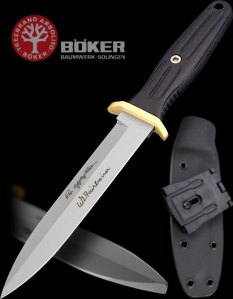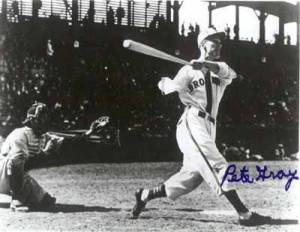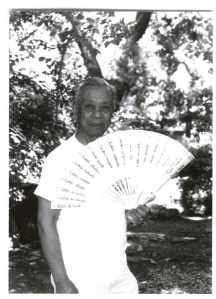Archive for arnis
How to Improve Your Stick Takedowns
Posted in Technique with tags arnis, eskrima, kali, Master Hochheim, stick grappling, stick takedowns on October 17, 2010 by bigstickcombatThe Kali Master and the Ditch Digger: A Parable
Posted in humor, Uncategorized with tags arnis, eskrima, kali, self-defense, shovel on October 9, 2010 by bigstickcombatTwo men were walking down the street. They just so happened to be going into the same direction
and wound up side by side. To break the awkwardness, one asked the other, “So that’s a fancy uniform you got there. What do you do, karate or something like that?”
“Oh, no,” the other replied. “I’m Supreme Grandmaster Datu Smith. I am the world’s greatest combat expert, and study the world’s greatest style, Kili-Kili Kali.”
“You got a lotta patches there.”
“Yes, I do. I worked hard to earn them all, but the one I’m most proud of is the Kili-Kili- Kali International Ass. badge.” Supreme Grandmaster Datu Smith then did a flourish with the two rattan sticks he was carrying.
“So you fight with them sticks?”
“Yes. And the single stick, knife, chain, nunchaku, staff, spear, sword, machete, and 23 other weapons. Would you like to learn Kili-Kili Kali?”
“Well, I’d like to, but things are kinda tight right now. I’m a ditch digger and I don’t make much.”
“But what would you do if you were attacked?”
“I’d just whack ’em with this here shovel. I been a ditch digger for years, and I used a shovel on the farm long before that. I’m pretty handy with a shovel.”
“You’d be lucky to last 10 seconds. You have no technique. On the other hand, I could teach you 17 different defenses with a stick, and that’s just on angle number 1!” Supreme Grandmaster Datu Smith briefly demonstrated an x block, a wing block, a gunting, a block and hit, a pass and hit, and a few more moves.
“Wow, them sticks look like blades in a blender. I dunno know, though. My dad was in the Korean War, and he took out a guy with one of those little shovels.”
 “An entrenching tool. A guy like that with no skill and no training is lucky to survive.”
“An entrenching tool. A guy like that with no skill and no training is lucky to survive.”
They were so engaged in their conversation that both men were surprised by the wild eyed man at the street corner. He was high on something. His matted hair and glassy red eyes created the impression of a rabid animal.
“I’ve got it.” Supreme Grandmaster Datu Smith clenched both sticks and began to move in close –after all, he was a master of close range combat. He stepped and then seemed to freeze for a moment. “Should I merge, or meet? Maybe an X block follwed by an… no, wait, how about an abaniko to the hand, followed by a…”
As he was debating his next move, the psycho lunged forward and stabbed him.
The ditch digger brought the shovel resting on his shoulder right down on the psycho. The flat of the blade struck the deranged man on the skull, and clanged like a bell. It was a strike powered by both hands, calloused by long years of hard work. He had launched the strike without even thinking, and struck the mad man with the knife a second time as he fell.
The ditch digger waited for the ambulance to come for the two men. The martial arts expert was losing a lot of blood, but the knife had missed his heart.
As Supreme Grandmaster Datu Smith was wheeled on the gurney into a waiting ambulance, he weakly whispered to the ditch digger, “Don’t thank me, I was just doing what any other Supreme Grandmaster Datu of Kili-Kili Kali would have done.” He then gripped the ditch digger’s hand briefly and let go as the ambulance doors were shut.
The ambulance raced off with lights flashing and sirens wailing. The ditch digger looked down at his hand. Resting in his palm was a blood stained business card for Supreme Grandmaster Datu Smith and Kili-Kili Kali.
Lessons from the Besh Wedge
Posted in American Arts, Masters and History, Weapons with tags Applegate, arnis, Beshara, Cooper, eskrima, Fairbairn, FMA, kali, knives, Sykes on October 2, 2010 by bigstickcombatYesterday I wrote about an innovation in knife design, the Besh Wedge. Beshara was inspired by the Fairbairn Sykes knife, and aimed to improve it. I think there are 3 different philosophies, or maybe just unspoken assumptions in the martial arts:
1) The Old Ways Cannot Be Improved. Some would say that the old classics like “Kill or Be Killed” or “Cold Steel,” have the best combat knowledge. Anything “new” is only reinventing the wheel.
This view is common in the martial arts; Sensei X, Guro X, Datu X, Grandmaster X, has the world’s greatest system. Any attempts to “improve” the ultimate system are useless and counterproductive, not to mention an insult to the old masters. Often this view is supported by references to the style going back two thousand years, back into the mists of time, etc.
2) The Old Ways Are Outdated. Some would say, “What could I learn from Fairbairn, some old guy from WWII?” After all, white guys don’t really know anything compared to all of the Asian grandmasters. “Hey, I study Ok-ok Kali, I could run circles around some old geezer like Cooper, Fairbairn, Applegate, etc.”
3) Refine the System. This is a saying of GM Estalilla. We should as martial artists continually strive to refine the system, meaning make improvements. I would begin by respecting the old masters, whether their art was Asian or Western. All of us must acknowledge that we have a debt to those who came before us –we owe them for passing down to us a martial arts heritage.
However, acknowledging the contributions of those before while striving to improve the art does not disrespect them –it honors them. That is what Brent Beshara did –beginning from a place of respect for the old masters, he asked himself how he could improve their ideas.
The Besh Wedge shows that there are new ideas. The best ideas are those that are simple, yet simple in a way that no one else has ever thought of.
New Blade Design: The Besh Wedge
Posted in American Arts, Weapons with tags arnis, Besh Wedge, Beshara, eskrima, FairBairn-Sykes dagger, kali, knife fighting, knifes, knives, stick fighting on October 1, 2010 by bigstickcombatI was riffling through the pages of a magazine at the local Wal-Mart the other day, when I was surprised to see a new knife design. Just when you think it’s all been done, a special forces operator, Brent Beshara, invented a new knife design, which he calls the Besh Wedge.
Beshara was interested in the Fairbairn-Sykes dagger, a classic double-edged dagger from WWII, but found that the tip was fragile and tended to break. For a soldier in the field, a knife is more of a tool used to pry things open or cut cords than a fighting weapon. As a result, the tip of a dagger designed as a weapon had the tendency to break when employed as a tool.
One day while grinding the edge on a blade, Beshara has a sudden insight: he beveled one edge on
top of the blade, and beveled the edge on the other side underneath. The two beveled edges, one on the top and one on the bottom, met at a chisel point. It can be hard to grasp the concept from just a written description, so study the pictures here.
These factors create a knife that keeps its edge longer and has a much stronger thrusting point, much more resistant to breakage.
Pete Gray: Baseball Warrior
Posted in American Arts, Princples and Theory with tags arnis, baseball bat, eskrima, kali, one-handed, Pete Gray, stick fighting on September 21, 2010 by bigstickcombatPete Gray was a professional baseball play despite the fact that he only had one arm! In the minor leagues Pete stole
63 bases and had a .333 batting average, which earned him an MVP award.
Pete is amazing for overcoming the disadvantage of batting with just one arm. Think how hard it would be to bat with just one arm. How many Filipino martial artists are handicapping themselves by swinging the stick with just one arm?
One unexpected difficulty Pete had in batting was an inability to hit a breaking ball. Because he only had one arm, Pete could not check his swing. One of my discoveries as I explored the two-handed method of stick wielding, holding the stick like a baseball bat, is that the second hand adds an extra element of control. Having a second hand on the stick helps you to redirect the stick, to brake it, and to exert greater control on trick strikes that change direction. The second hand helps you to control the opponent’s stick at contact, like a live hand.
“Gray also proved himself an accomplished bunter. In order to bunt, he would plant the knob of the bat against his side, and would then slide his hand about one-third of the way up the shaft of the bat.” This ability to move from stick grip at the end of the bat to carry grip at the middle of the bat just might come in handy against a closing opponent.
Above all else, Pete Gray is a great example of what all of us are capable of if we push ourselves to overcome our limitations.

















Beer Steins as Weapons
Posted in Commentary, Weapons with tags arnis, beer stein assaults, eskrima, FMA, impromptu weapons, kali, Oktoberfest on September 30, 2010 by bigstickcombatTraditional German Weapon
In Germany during Oktoberfest there has been a rash of assaults with beer steins. 32 assaults, in fact.
And not just any beer steins –we’re talking about one-liter beer steins. In eight cases the beer stein has broken. In many other cases, someone’s skull was fractured. In the words of one German police officer, “…every hit is potentially fatal. In our institute, we have just performed an autopsy on someone who got a beer stein to the head.”
A beer stein is not designed as a weapon. It’s designed as a utility.
A beer stein does not handle like a rattan stick, so we must ask to what extent FMA techniques can be applied to the beer stein. Can you do an x block? Can you do a wing block? Can you do an abaniko strike? Can you do sinawali if you have two beer steins? Can you do hubud-lubud (trapping hands) with it?
If you can do any of these techniques with a beer stein, do they make sense? Would they be effective, powerful techniques?
What if we thought of direct techniques that a person could learn and use with a hammer, beer stein, coffee mug, tire iron, and so on? Such a style would be simpler, because we would have to cut out the more complex techniques.
I suppose the disadvantages are that there would be fewer, easier techniques, and so DVD sales would drop. After all, who’s going to buy “The Death Master Series: Coffee Mug Basics, Vol I, Coffee Mug Counter Tactics, Vol. II, Advanced Coffee Mug, Vol III”?
Maybe it would help if I called it “Baso ng Kamatayan,” and talked about how ancient Filipinos in Mindanao made tuba steins from hand-blown glass.
6 Comments »